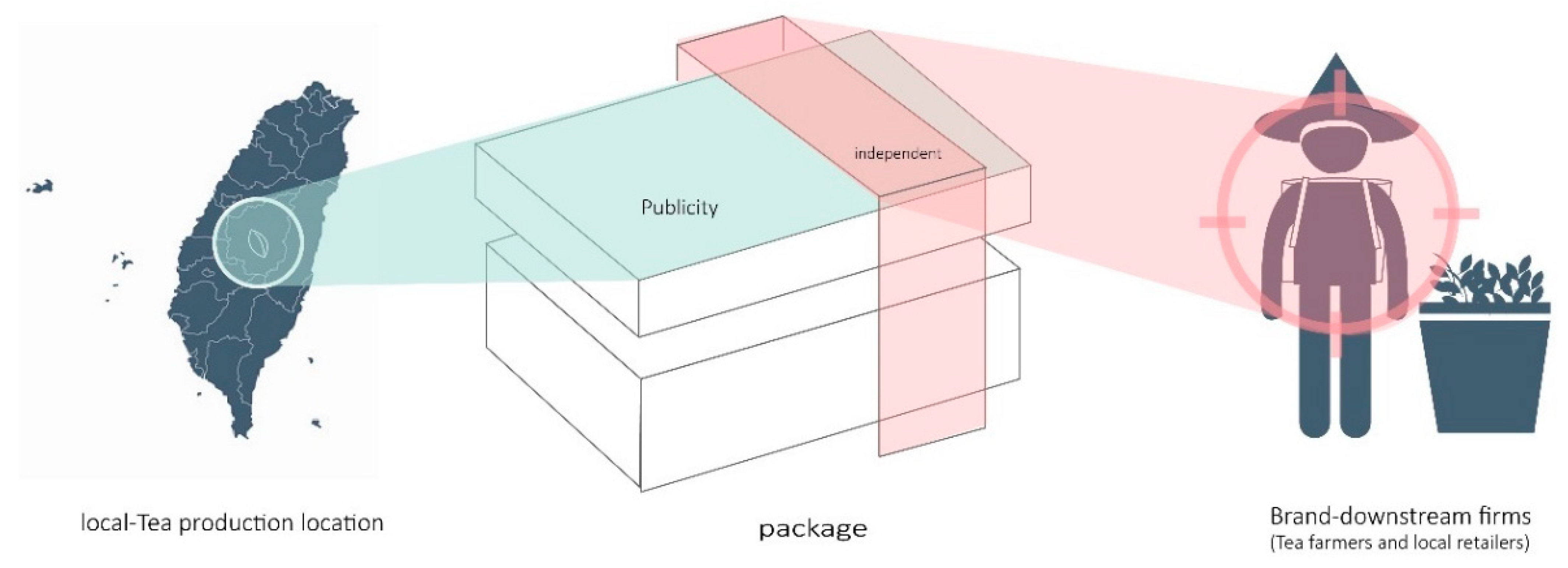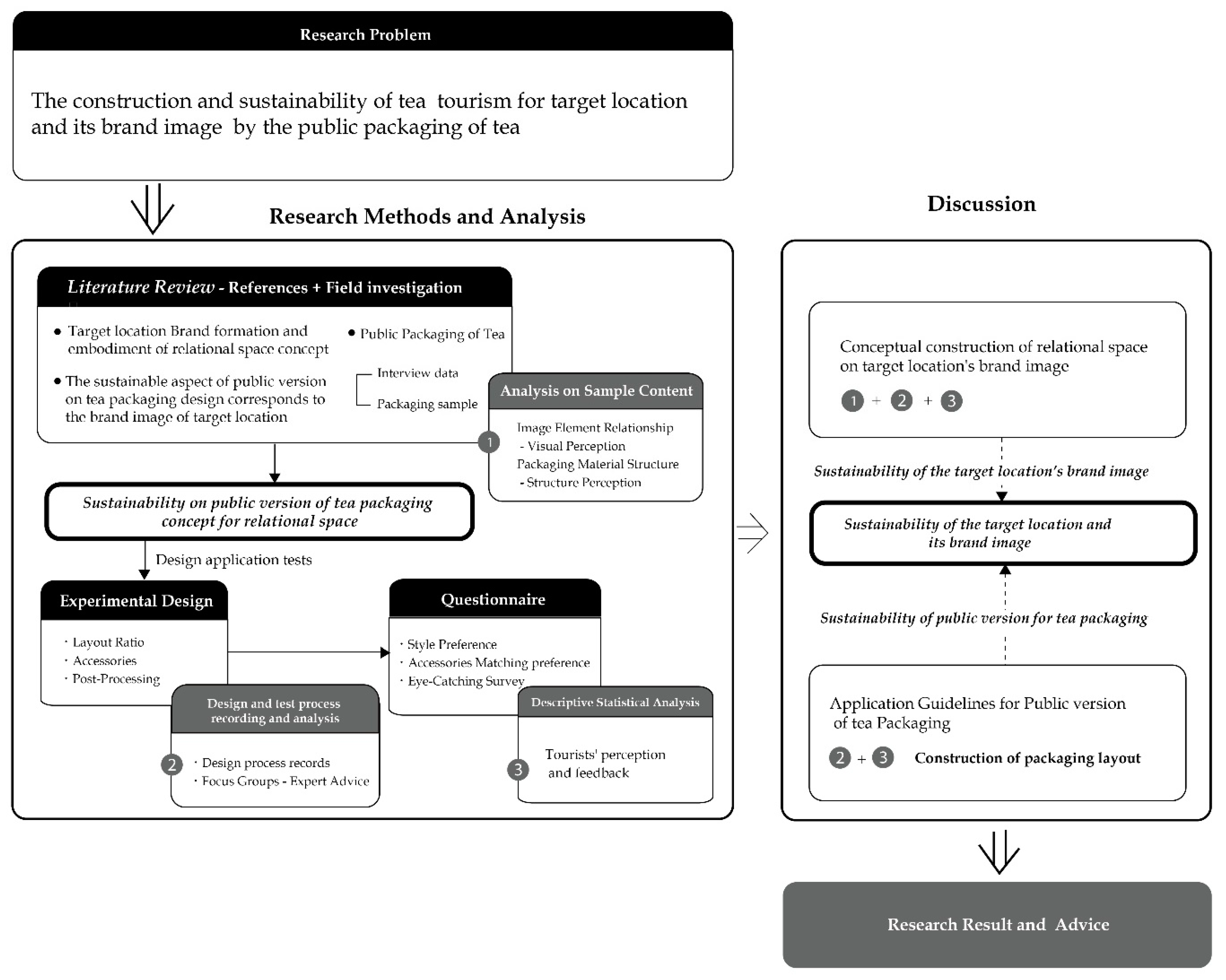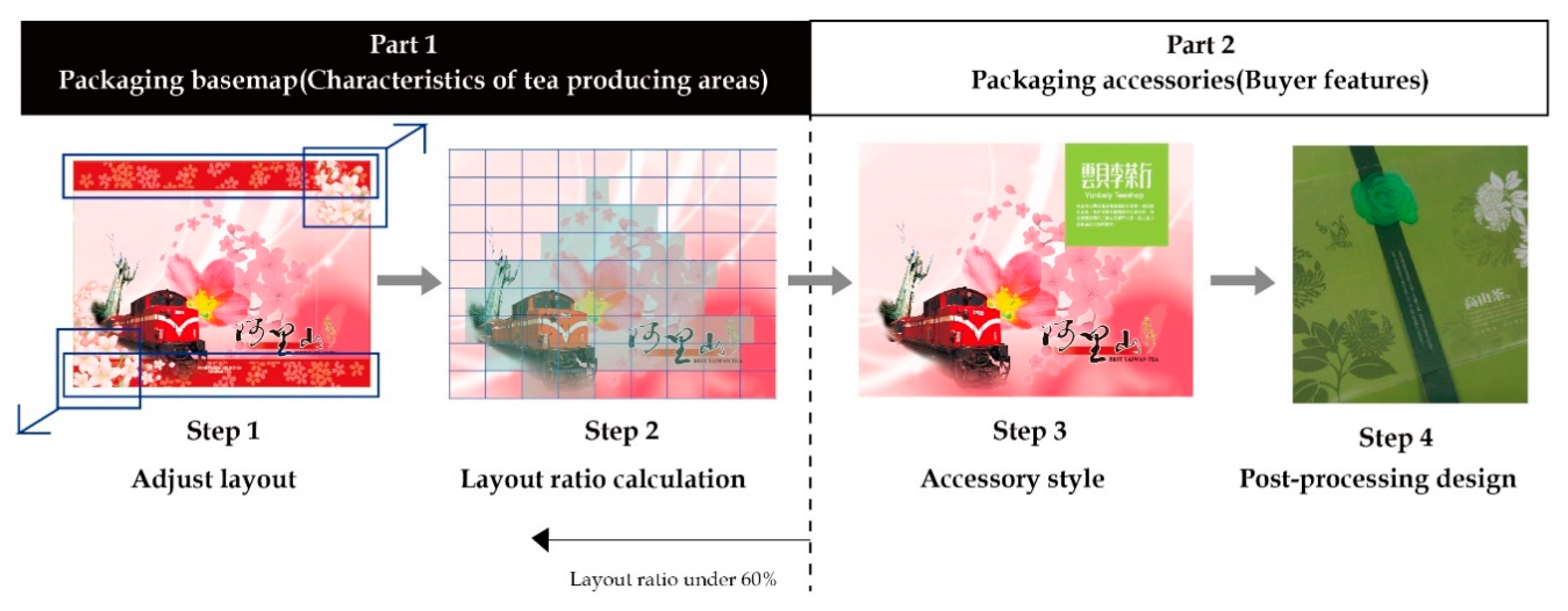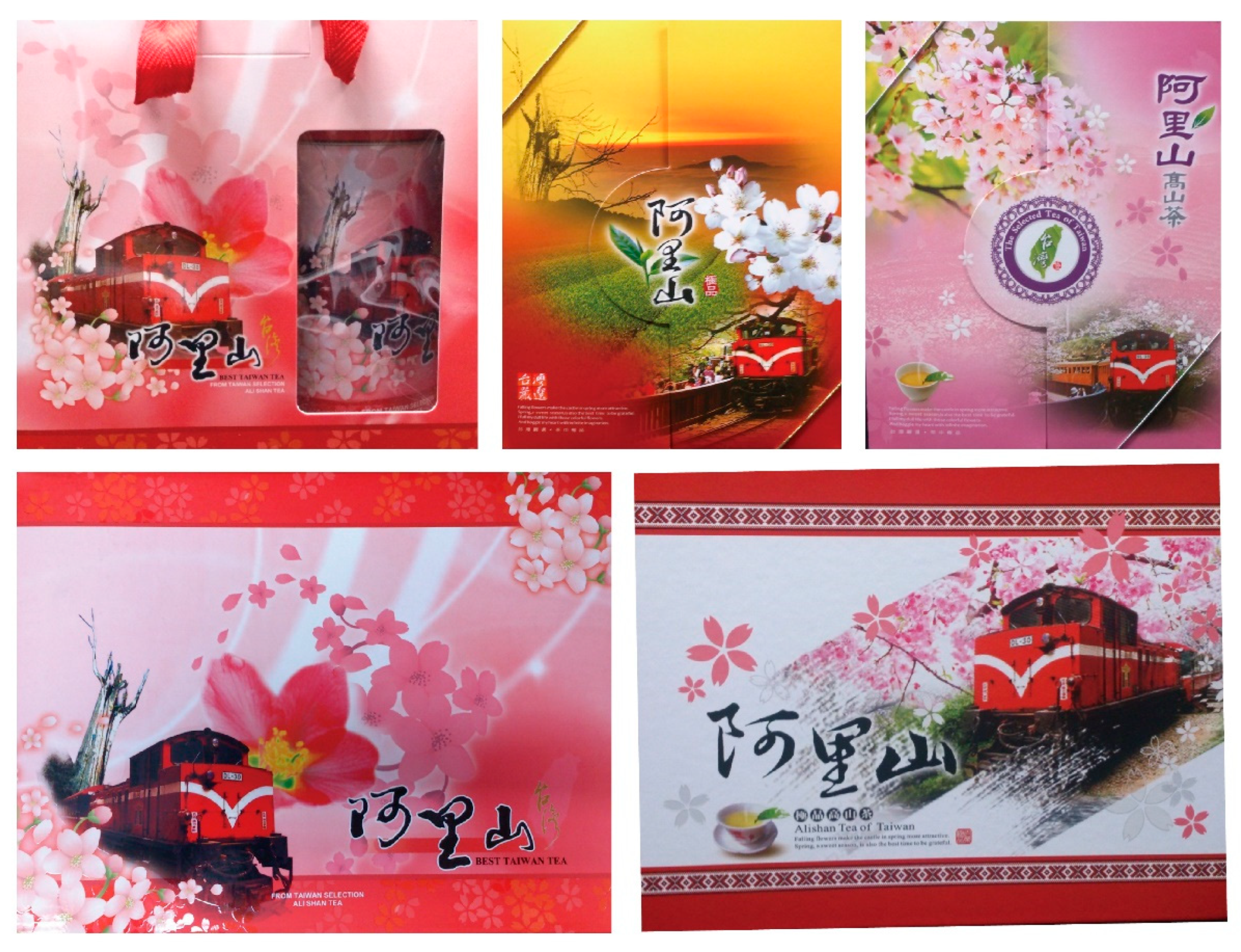Creating Sustainable Development of the Destination with Tea Public Version Packaging Design by Obtaining Relational Space Concept
Abstract
1. Introduction
2. Literature Review
2.1. Brand Formation of Destination and Embodiment of Relational Space Concept
2.2. Public Version of Tea Packaging
2.3. The Sustainable Orientation of the Tea Public Version Packaging Design Corresponds to the Brand Image of the Place
Literature Summary
3. Research Methods
3.1. Field Investigation
3.2. Experimental Design
- Application of design method: the designer proposes a redesign sample of tea public version packaging;
- Inspection of samples: suggestions from experts of the focus group on screening of redesigned samples and post-processing of accessories.
3.3. Questionnaire
4. Research Analysis and Discussion
4.1. The Relational Spatial Context Displayed by the Visual and Structural Aspects of the Existing Packaging Samples
4.2. Application Key Elements and Application Guidelines of Tea Public Version Packaging Design
4.3. The Partnership of Mutual Benefit and Symbiosis Is Visualized in the Tea Public Version Packaging Design
5. Conclusions
5.1. Brand Image Creation and Sustainable Development of Tea Tourism Destinations by Tea Public Packaging
5.2. Tea Public Packaging Drives the Sustainable Development of Tourism Destination-Related Industries
5.3. Study Limitations
Author Contributions
Funding
Institutional Review Board Statement
Informed Consent Statement
Data Availability Statement
Conflicts of Interest
References
- Huang, P.C. Research the Transition of Tea Industry along the Alishan Provincial Highway. Master’s Thesis, National Chung Hsing University, Taichung, Taiwan, 2013. [Google Scholar]
- Hashimoto, A. Tea and Tourism: Tourists, Traditions, and Transformations; Channel View Publications: Bristol, UK, 2008; ISBN 978-1-84541-057-5. [Google Scholar]
- Su, M.M.; Wall, G.; Wang, Y. Integrating tea and tourism: A sustainable livelihoods approach. J. Sustain. Tour. 2019, 27, 1591–1608. [Google Scholar] [CrossRef]
- Zeng, T.; Durif, F. The influence of consumers’ perceived risks towards eco-design packaging upon the purchasing decision process:An exploratory study. Sustainability 2019, 1, 6131. [Google Scholar] [CrossRef]
- García-Arca, J.; Garrido, A.T.G.P.; Prado-Prado, J.C. “Sustainable packaging logistics”. The link between sustainability and competitiveness in supply chains. Sustainability 2017, 9, 1098. [Google Scholar] [CrossRef]
- Wang, R.L.; Hsu, T.F.; Hu, C.Z. A Bibliometric Study of Research Topics and Sustainability of Packaging in the Greater China Region. Sustainability 2021, 13, 5384. [Google Scholar] [CrossRef]
- Guillard, V.; Gaucel, S.; Fornaciari, C.; Angellier-Coussy, H.; Buche, P.; Gontard, N. The next generation of sustainable food packaging to preserve our environment in a circular economy context. Front. Nutr. 2018, 5, 121. [Google Scholar] [CrossRef] [PubMed]
- Choi, S.; Lee, S.; Friske, W. The effects of featured advertising and package labeling on sustainability of cause-related marketing (CRM) products. Sustainability 2018, 10, 3011. [Google Scholar] [CrossRef]
- Pamukçu, H.; Saraç, Ö.; Aytuğar, S.; Sandıkçı, M. The effects of local food and local products with geographical indication on the development of tourism gastronomy. Sustainability 2021, 13, 6692. [Google Scholar] [CrossRef]
- Wang, N. A comparison of Chinese and British tea culture. Asian Cult. Hist. 2011, 3, 13. [Google Scholar] [CrossRef][Green Version]
- Luo, Q. A Comparative Study of Tea Culture and Its Connotation between Chinese and English—Based on the Matter, Behavior and Spirit. In Proceedings of the 3rd International Conference on Humanities Science, Nanjing, China, 8–10 June 2018; Atlantis Press: Dordrecht, The Netherlands, 2018; pp. 214–217. [Google Scholar]
- Harvey, D. Justice, Nature and the Geography of Difference; Blackwell Publishers: Cambridge, MA, USA, 1996; ISBN 155-7-866-805. [Google Scholar]
- Yu, L. The Saint of Tea: Sencha’s Tasty Is Meaningful; Shandong Pictorial Publishing House: Jinan, China, 2018; ISBN 978-7-5474-2611-1. [Google Scholar]
- Chen, Y.H. Taiwanese Tea: A Case of Monopoly Rent by Social Construction. Taiwan. J. Sociol. 2007, 39, 107–157. [Google Scholar]
- Lin, T. The Impact of Tea Competitions to the Development of Local Tea Business—A Case Study of Tea Competitions of the Lu-Gu Farmer”s Association. Master’s Thesis, National Chung Hsing University, Taichung, Taiwan, 2004. [Google Scholar]
- Liang, B.K. Exploration of Industry Development and Origin Certification of Lugu Dongding Wulong Tea. J. Taiwan Land Res. 2014, 17, 29–56. [Google Scholar]
- Chung, C.P.; Chen, C.C.; Lee, C.F. Effects of tea competitions on tea production and distribution under system dynamics perspective. Mingchi Inst. Technol. J. 2016, 44, 71–92. [Google Scholar]
- Chen, J.; Wei, S.Q.; Li, F. The Evolution Path and Network of Agricultural Clusters from the Perspective of “Co-Location Clusters”: A Case Study of the Zhangping Tea Industry in Fujian Province. Trop. Geogr. 2021, 41, 364–373. [Google Scholar]
- Council of Agriculture (COA). Executive Yuan, Taiwan. Taiwan Tea Knowledge. Available online: https://fae.coa.gov.tw/food_item.php?type=AS03&id=113 (accessed on 1 June 2022).
- Harvey, D. Cosmopolitanism and the Geographies of Freedom; Columbia University Press: New York, NY, USA, 2009; ISBN 023-114-8461. [Google Scholar]
- Chen, Y.C. The Effects of Elements of Non-Copyrighted Tea Packing Design on Tea Merchants’ Choices in Mingjian, Nantou. Master’s Thesis, Tunghai Unviersity, Taichung, Taiwan, 2010. [Google Scholar]
- Huang, R.H. The Research for Pattern Design of Commercial Pack; Great Social and Cultural Business Publishing House: Taichung, Taiwan, 1990. [Google Scholar]
- Jiang, I.C. The Influence of Interesting Snack Package Design on Consumers’ Behavior. Master’s Thesis, National Taiwan University of Arts, New Taipei City, Taiwan, 2010. [Google Scholar]
- Huang, Y.Y. Analysis of the Current Situation of Tea Industry in Taiwan and the Government’s Policy in Response: WTO and ECFA as Examples. Master’s Thesis, National Chung Cheng University, Chiayi, Taiwan, 2011. [Google Scholar]
- Huang, J.C.; Chen, L.N. Baozhuang Yishu Sheji; Chongqing University Press: Chungking, China, 2002; ISBN 978-7-5624-2625-7. [Google Scholar]
- Long, D.Y. Commercial Package Design; Lemon Yellow Cultural Business Company: Taipei, Taiwan, 1982. [Google Scholar]
- Shin, H.Y. Analysis of Tea Packaging Methods and It’s Influence upon Consumers-TEA Shops of Taipei Case Study. Master’s Thesis, National Taiwan University of Arts, New Taipei City, Taiwan, 2007. [Google Scholar]
- Lin, C.Y. Creation Study On The Development Trend Of Taiwan Tea Packaging Design: Case Of YI RI Tea Bags Design. Master’s Thesis, National University of Tainan, Tainan, Taiwan, 2015. [Google Scholar]
- Li, Y.J.; Yan, H.Q. Study on the relationship between economic development and environmental pollution in GUANGXI based on kuznets curve. Sustain. Dev. 2020, 10, 357–367. [Google Scholar] [CrossRef]
- Pereira, L.; Mafalda, R.; Marconcini, J.M.; Mantovani, G.L. The use of sugarcane bagasse-based green materials for sustainable packaging design. In ICoRD’15–Research into Design across Boundaries; Springer: New Delhi, India, 2015; Volume 2, pp. 113–123. [Google Scholar]
- Abdul Khalil, H.P.S.; Davoudpour, Y.; Saurabh, C.K.; Hossain, M.S.; Adnan, A.S.; Dungani, R.; Paridah, M.T.; Islam Sarker, M.Z.; Nurul Fazita, M.R.; Syakir, M.I.; et al. A review on nanocellulosic fibres as new material for sustainable packaging: Process and applications. Renew. Sustain. Energy Rev. 2016, 64, 823–836. [Google Scholar] [CrossRef]
- García-Arca, J.; Comesaña-Benavides, J.A.; González-Portela Garrido, A.T.; Prado-Prado, J.C. Rethinking the box for sustainable logistics. Sustainability 2020, 12, 1870. [Google Scholar] [CrossRef]
- Georgakoudis, E.D.; Tipi, N.S.; Bamford, C.G. Packaging redesign–benefits for the environment and the community. Int. J. Sustain. Eng. 2018, 11, 307–320. [Google Scholar] [CrossRef]
- Rodrigue, J.P.; Slack, B.; Comtois, C. Green logistics. In Handbook of Logistics and Supply-Chain Management; Emerald Group Publishing Limited: Amsterdam, The Netherlands, 2017. [Google Scholar]
- Mollenkopf, D.; Closs, D.; Twede, D.; Lee, S.; Burgess, G. Assessing the viability of reusable packaging: A relative cost approach. J. Bus. Logist. 2005, 26, 169–197. [Google Scholar] [CrossRef]
- Aronsson, H.; Brodin, M.H. The environmental impact of changing logistics structures. Int. J. Logist. Manag. 2006, 17, 394–415. [Google Scholar] [CrossRef]
- Merz, M.A.; He, Y.; Vargo, S.L. The evolving brand logic: A service-dominant logic perspective. J. Acad. Mark. Sci. 2009, 37, 328–344. [Google Scholar] [CrossRef]
- Verganti, R. Design-Driven Innovation: Changing the Rules of Competition by Radically Innovating What Things Mean; Harvard Business Press: Brighton, MA, USA, 2009; pp. 33–54. [Google Scholar]
- De Kay, M. Integral Sustainable Design: Transformative Perspectives; Bennett, S., Ed.; Earthscan from Routledge: New York, NY, USA, 2011; pp. 3–128. [Google Scholar]
- Dauvergne, P.; Lister, J. Eco-Business:A Big-Brand Takeover of Sustainability; The MIT Press: Cambridge, MA, USA, 2013; ISBN 978-0-262-01876-0. [Google Scholar]
- Voon, T.Y.; Yazdanifard, R. Green Marketing Strategies, Sustainable Development, Benefits and Challenges and Constraints. Center for Southern New Hamphire University (SNHU) Programs, HELP College of Art and Technology. 2014. Available online: https://www.researchgate.net/publication/264992117 (accessed on 25 June 2022).
- Ho, J.L.; Lee, C.L. Trends and Practices of Sustainable Development and Corporate Social Responsibility Report. Taiwan Account. Rev. 2017, 12, 359–366. [Google Scholar]
- Lu, X.; Tong, Y. Study on the Packing Design of Tourism Product of Intangible Cultural Heritage Based on Hui’an Women’s Dress. In 4th International Conference on Arts, Java, 14 November 2018; Atlantis Press: Dordrecht, The Netherlands, 2018; pp. 575–578. [Google Scholar]
- Zhihong, L.; Yu-ting, Z.H.A.N.G. Tourist Souvenirs of Eco-packaging Structure Optimization Design in Perspective of Lijiang River Culture. In 2012 National Conference on Information Technology and Computer Science, 16–18 November 2012; Atlantis Press: Dordrecht, The Netherlands, 2012; pp. 557–559. [Google Scholar]
- Jarossová, M.A.; Gordanová, J. Folk Motifs as a New trend in Foods and Beverages Packaging Design. Studia Commer. Bratisl. 2019, 12, 34–47. [Google Scholar] [CrossRef][Green Version]
- Li, W.-T. A study on the public version of tea packaging design. Master’s Thesis, National Yunlin University of Science and Technology, Douliu, Taiwan, 2014. [Google Scholar]
- Lupton, E.; Phillips, J.C. Graphic Design the New Basics; Long Sea International Book: New Taipei City, Taiwan, 2008; ISBN 978-9-8670-2232-5. [Google Scholar]
- Jung, T. A Study on Imagery Evaluation and Visual Communication Design of Layout—A Case Study of Chinese Face Rate; Wu-Nan Book Inc.: Taipei, Taiwan, 2001. [Google Scholar]
- Cheng, Y.H.; Lan, Y.C. Research of Analyzing the Web Page Layout Design by the Rule of Thirds. J. Des. Sci. 2012, 15, 103–131. [Google Scholar]
- Ministry of Transportation and Communications (MOTC). Tourism Bureau, Taiwan. Alishan National Forest Recreation Area. Available online: https://www.taiwan.net.tw/m1.aspx?sNo=0001016&id=10949 (accessed on 1 April 2022).
- Murgado, E.M. Turning food into a gastronomic experience: Olive oil tourism. Options Mediterr. 2013, 106, 97–109. [Google Scholar]
- Gartner, W.C. Brand equity in a tourism destination. Place Branding Public Dipl. 2014, 10, 108–116. [Google Scholar] [CrossRef]
- Hsiung, T.F.; Cheng, Y.H.; Han, Z.X. Sustainable Partnership: Operational Condition Analysis for Brand Value Co-Creation. Sustainability 2021, 13, 6516. [Google Scholar] [CrossRef]









| Processing Methods (Code) | Seal (SL) | Sticker (SR) | Straps (BE) | Wax Seal (WL) | |
|---|---|---|---|---|---|
| Option on Changes (Code) | |||||
| accessory Shape (S) | rectangle (1) | S1 | S1 | S1 | X |
| square (2) | X | S2 | S2 | X | |
| triangle (3) | X | S3 | S3 | X | |
| round shape (4) | X | S4 | S4 | S4 | |
| organic shape (5) | S5 | S5 | S5 | X | |
| Color (C) | analogous color (1) | C1 | C1 | C1 | C1 |
| high contrast (2) | C2 | C2 | C2 | C2 | |
| Letter (T) | Serif (1) | T1 | T1 | T1 | T1 |
| Sans-serif (2) | T2 | T2 | T2 | T2 | |
| Chinese calligraphy (3) | T3 | T3 | T3 | T3 | |
| calligraphy (4) (self-designed) | T4 | T4 | T4 | T4 |
Publisher’s Note: MDPI stays neutral with regard to jurisdictional claims in published maps and institutional affiliations. |
© 2022 by the authors. Licensee MDPI, Basel, Switzerland. This article is an open access article distributed under the terms and conditions of the Creative Commons Attribution (CC BY) license (https://creativecommons.org/licenses/by/4.0/).
Share and Cite
Li, W.-T.; Cheng, Y.-H. Creating Sustainable Development of the Destination with Tea Public Version Packaging Design by Obtaining Relational Space Concept. Sustainability 2022, 14, 9256. https://doi.org/10.3390/su14159256
Li W-T, Cheng Y-H. Creating Sustainable Development of the Destination with Tea Public Version Packaging Design by Obtaining Relational Space Concept. Sustainability. 2022; 14(15):9256. https://doi.org/10.3390/su14159256
Chicago/Turabian StyleLi, Wan-Ting, and Yueh-Hsiu Cheng. 2022. "Creating Sustainable Development of the Destination with Tea Public Version Packaging Design by Obtaining Relational Space Concept" Sustainability 14, no. 15: 9256. https://doi.org/10.3390/su14159256
APA StyleLi, W.-T., & Cheng, Y.-H. (2022). Creating Sustainable Development of the Destination with Tea Public Version Packaging Design by Obtaining Relational Space Concept. Sustainability, 14(15), 9256. https://doi.org/10.3390/su14159256






